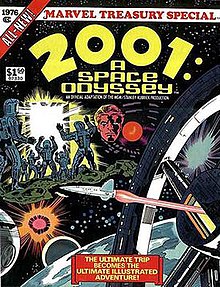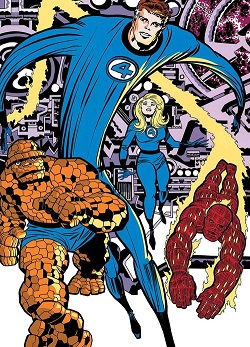
The Fantastic Four is a superhero team appearing in American comic books published by Marvel Comics. The team debuted in The Fantastic Four #1, helping usher in a new level of realism in the medium. It was the first superhero team created by artist/co-plotter Jack Kirby and editor/co-scripter Stan Lee, and through this title that the "Marvel method" style of production came into prominence.
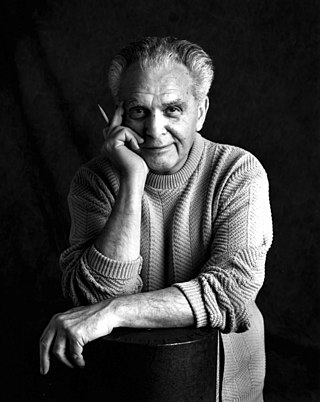
Jack Kirby was an American comic book artist, widely regarded as one of the medium's major innovators and one of its most prolific and influential creators. He grew up in New York City and learned to draw cartoon figures by tracing characters from comic strips and editorial cartoons. He entered the nascent comics industry in the 1930s, drawing various comics features under different pen names, including Jack Curtiss, before ultimately settling on Jack Kirby. In 1940, he and writer-editor Joe Simon created the highly successful superhero character Captain America for Timely Comics, predecessor of Marvel Comics. During the 1940s, Kirby regularly teamed with Simon, creating numerous characters for that company and for National Comics Publications, later to become DC Comics.

"Fourth World" was a metaseries of connected comic book titles written and drawn by Jack Kirby and published by DC Comics from 1970 to 1973. Although they were not marketed under this title until the August–September 1971 issues of New Gods and Forever People, the terms Fourth World and Jack Kirby's Fourth World have gained usage in the years since. Kirby created the Fourth World concept in the 1970s. The series is a science-fiction based mythology that revolves around ancient space deities known as the New Gods. The New Gods are similar to the gods of Earth lore.
The Space Odyssey series is a series of science fiction novels by the writer Arthur C. Clarke. The first novel was developed concurrently with Stanley Kubrick's film version and published after the release of the film. The second was made into a feature film, released in 1984, respectively. Two of Clarke's early short stories have ties to the series.

Brent Anderson is an American comics artist known for his work on X-Men: God Loves, Man Kills and the comic book series Astro City.
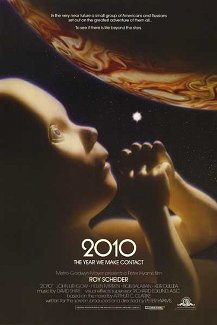
2010: The Year We Make Contact is a 1984 American science fiction film written, produced, shot and directed by Peter Hyams. It is a sequel to Stanley Kubrick's 1968 film 2001: A Space Odyssey and is based on Arthur C. Clarke's 1982 sequel novel, 2010: Odyssey Two. The film stars Roy Scheider, Helen Mirren, Bob Balaban and John Lithgow, along with Keir Dullea and Douglas Rain of the cast of the previous film.

Steve Rude is an American comics artist. He is best known as the co-creator of Nexus.
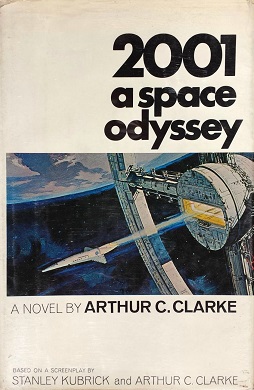
2001: A Space Odyssey is a 1968 science fiction novel by British writer Arthur C. Clarke. It was developed concurrently with Stanley Kubrick's film version and published after the release of the film. Clarke and Kubrick worked on the book together, but eventually only Clarke ended up as the official author. The story is based in part on various short stories by Clarke, including "The Sentinel". By 1992, the novel had sold three million copies worldwide. An elaboration of Clarke and Kubrick's collaborative work on this project was made in the 1972 book The Lost Worlds of 2001.
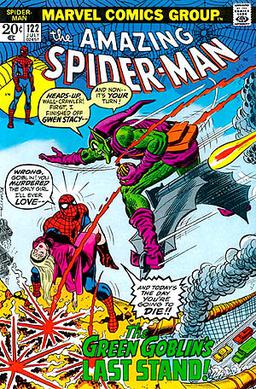
The Bronze Age of Comic Books is an informal name for a period in the history of American superhero comic books, usually said to run from 1970 to 1985. It follows the Silver Age of Comic Books and is followed by the Modern Age of Comic Books.
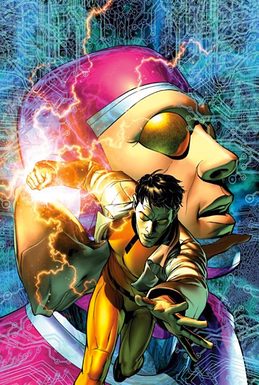
Machine Man is an android superhero appearing in American comic books published by Marvel Comics. The character was created by Jack Kirby for 2001: A Space Odyssey #8, a comic written and drawn by Kirby featuring concepts based on the eponymous 1968 Stanley Kubrick feature film and Arthur C. Clarke's 1968 novel. Shortly thereafter, Machine Man spun off into his own Kirby-created series. He is a robot, the only survivor of a series, raised as a human son of scientist Abel Stack, who was killed removing his auto-destruct mechanism, and further evolved to sentience by a Monolith.
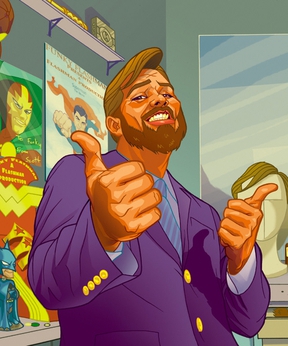
Funky Flashman is a fictional character, an entrepreneur in the DC Universe. Created by Jack Kirby, the character first appeared in the pages of Mister Miracle during the early 1970s. He is popularly considered a satiric caricature of Stan Lee, Kirby's former artistic collaborator at Marvel Comics with whom he had a falling-out. Flashman's attempts to rip off Mister Miracle reflect Kirby's view that Lee exploited his work at Marvel in the 1960s.
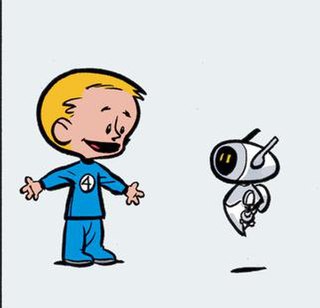
H.E.R.B.I.E. is a fictional robot appearing in American comic books published by Marvel Comics. The character was initially conceived for The New Fantastic Four and integrated into the comics continuity shortly afterwards. The character is usually depicted as an ally of the Fantastic Four.

Topps Comics was a division of Topps Company, Inc. that published comic books from 1993 to 1998, beginning its existence during a short comics-industry boom that attracted many investors and new companies. It was based in New York City, at 254 36th Street, Brooklyn, and at One Whitehall Street, in Manhattan.
2001 was a common year starting on Monday of the Gregorian calendar.
Since its premiere in 1968, the film 2001: A Space Odyssey has been analysed and interpreted by numerous people, ranging from professional movie critics to amateur writers and science fiction fans. The director of the film, Stanley Kubrick, and the writer, Arthur C. Clarke, wanted to leave the film open to philosophical and allegorical interpretation, purposely presenting the final sequences of the film without the underlying thread being apparent; a concept illustrated by the final shot of the film, which contains the image of the embryonic "Starchild". Nonetheless, in July 2018, Kubrick's interpretation of the ending scene was presented after being newly found in an early interview.

Jack Kirby was a prolific comics creator who created many American comic books and characters, particularly for Marvel Comics and DC Comics.

Michael W. Royer is an American comics artist and inker, best known for his work with pencilers Russ Manning and Jack Kirby. In later life Royer became a freelance product designer and character artist for The Walt Disney Company.
Marvel Treasury Edition is an American comic book series published by Marvel Comics from 1974 to 1981. It usually featured reprints of previously published stories but a few issues contained new material. The series was published in an oversized 10" x 14" tabloid format and was launched with a collection of Spider-Man stories. The series concluded with the second Superman and Spider-Man intercompany crossover. Marvel also published treasuries under the titles Marvel Special Edition and Marvel Treasury Special as well as a number of one-shots.

Sequart Organization is an online magazine that focuses on the study of popular culture and the promotion of comic books as an art form. Sequart also publishes books and produces documentary films. It was founded in 1996 by Julian Darius. Sequart's editor-in-chief is Mike Phillips.
In popular culture, Stanley Kubrick's 1968 science fiction film 2001: A Space Odyssey has had a significant impact in such diverse cultural forms and media as film, literature, music and technology.
